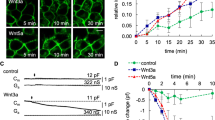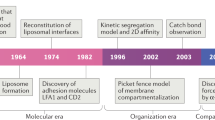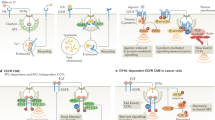Abstract
ENDOCYTOSIS is the process by which cells internalise part of the plasma membrane in association with extracellular components; they engulf large particles by phagocytosis and internalise components in the fluid phase by pinocytosis. Discrimination of phagocytosis from pinocytosis has been based on the size of the particle and the amount of energy required to internalise it, phagocytosis being inhibited more readily by metabolic poisons than pinocytosis1–3. This is consistent with the view that more energy is required to internalise a large surface area than is needed for a small surface area. Vasiliev et al.4 described “contact inhibition of phagocytosis”: when cultured epithelial cells, but not fibroblasts, became confluent, the rate of phagocytosis decreased considerably. I report here that confluent cultured epithelial cells are not inhibited in their ability to undergo pinocytosis, but exhibit a greater rate of pinocytosis than do non-confluent cells. This difference is not due to diffusable factors, but is the result of cell contact.
This is a preview of subscription content, access via your institution
Access options
Subscribe to this journal
Receive 51 print issues and online access
$199.00 per year
only $3.90 per issue
Buy this article
- Purchase on Springer Link
- Instant access to full article PDF
Prices may be subject to local taxes which are calculated during checkout
Similar content being viewed by others
References
Karnovsky, M. L., Physiol. Rev., 42, 143–168 (1962).
Cohn, Z. A., J. exp. Med., 124, 555–571 (1966).
Petitpierre-Gabathuler, M. P., and Rhyser, H. J-P., J. Cell Sci., 19, 141–156 (1975).
Vasiliev, S. M., Gelfand, I. M., Domina, L. U., Zacharova, D. S., and Jubimov, L., Proc. natn. Acad. Sci. U.S.A., 72, 719–722 (1975).
Steinman, R. M., and Cohn, Z. A., J. Cell Biol., 55, 186–204 (1972).
Steinman, R. M., Silver, J. M., and Cohn, Z. A., J. Cell Biol., 62, 949–969 (1974).
Rhyser, H. J. P., Science, 159, 390–396 (1968).
Kaplan, J., and Moskowitz, M., Biochim. biophys. Acta., 389, 290–305 (1974).
DiPasquale, X. X., and Bell, P. B., Jr, J. Cell Biol., 62, 198–214 (1974).
Lowry, O. H., Rosebrough, N. J., Farr, A. L., and Randall, R. J., J. biol. Chem., 193, 652–275 (1951).
Author information
Authors and Affiliations
Rights and permissions
About this article
Cite this article
KAPLAN, J. Cell contact induces an increase in pinocytotic rate in cultured epithelial cells. Nature 263, 596–597 (1976). https://doi.org/10.1038/263596a0
Received:
Accepted:
Issue Date:
DOI: https://doi.org/10.1038/263596a0
This article is cited by
-
Clathrin-independent endocytosis: an increasing degree of complexity
Histochemistry and Cell Biology (2018)
-
Lysosomal storage diseases: mechanisms of enzyme replacement therapy
The Histochemical Journal (1993)
-
Binding and incorporation of lecithin-cholesterol vesicles to lymphocytes: A spin-label study
The Journal of Membrane Biology (1982)
Comments
By submitting a comment you agree to abide by our Terms and Community Guidelines. If you find something abusive or that does not comply with our terms or guidelines please flag it as inappropriate.



